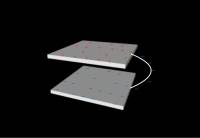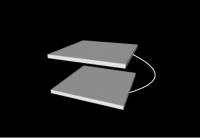Conventional Current vs Electron Current
Electron Current
Before, we defined the electron current as the number of electrons passing through a point per second. Because the electron current is made up of negative charges, the electron current will always flow opposite to the electric field. (This is a more general rule that you may remember from before - electrons will always move opposite to the direction of the electric field.) We will use a lower-case “i” to represent the electron current. $$i=\frac{\# electrons}{second}$$
We can generally write the electron current in terms of the electron density in the wire ($n$), which gives the number of electrons per volume of the wire that are free to move, the cross-sectional area of the wire ($A$), and the average speed of the electrons through the wire. $$i=nAv_{avg}$$ If we check the units of this equation we see that: $$\frac{\# electrons}{s}=\frac{\# electrons}{m^3}*m^2*\frac{m}{s}$$
Conventional Current
Conventional current is then defined as the number of coulombs passing through a point per second. In this case, we can find this by multiplying the electron current by the magnitude of the charge of an electron. If the charge carriers aren't electrons (e.g., some kind of ion), then you will need to use the charge of the charge carrier. We will use an upper-case “I” to represent the conventional current. $$I=\frac{\# Coulombs}{second}=|q|i$$ The conventional current is now positive (number of electrons times the magnitude of the charge). By “convention”, the conventional current flows in the opposite direction of the electron current. In other words, the conventional current will flow in the same direction as the electric field. The units of conventional current are $\frac{Coulombs}{second}=\frac{C}{s}=A$, which we call an Ampere or an Amp for short.
For historical reasons, much of what we work with in circuits is based off of conventional current rather than the electron current (much of what we know was established before we discovered it was the electrons that were free to move; you can thank Ben Franklin for that). However, remember that physically, the electrons are what move in a circuit.
Motivating Moving Charges
We will define the number of electrons passing through any given point in the wire per second as the electron current. At first, there will be many electrons traveling through the wire because of the strong repulsion from the negative plate and the strong attraction from the positive plate. This translates to a large electron current through the wire.
After some time has passed, the electron current through the wire decreases for three (related) reasons. First, there are fewer excess electrons available on the negative plate because many of the electrons have now traveled through the wire to the positive plate. This means that net charge on the negative plate has decreased and the net charge on the positive plate has decreased. Then because the net charge has decreased, the excess electrons on the negative plate feel a weaker repulsion from the other excess electrons and a weaker attraction from the positive plate. At the same time, the charge on both plates and the wire is redistributing itself as more electrons move onto the positive plate. The net effect of this redistribution on all conductors results in fewer electrons arriving at the positive plate. Ultimately, this means that there are fewer electrons passing through the wire per second.
After the wire has been connected for a long time, all of the excess electrons from the negative plate have moved through the wire, leaving both the (originally) negative and positive plates neutral. By this point, there are no charges moving through the wire so the electron current is zero. The charges on the plates and the wire stop redistributing and are now in a state of “static equilibrium.”
This example highlights a few important features about moving charges:
- Separation of charges - any time you have positive and negative charges separated by some distance, there is an electric field between those charges. There is also a change in electric potential between those charges. As you learned before, electric field and electric potential are related to electric force and electric potential energy respectively. This means that separated charges are a means to store energy. Like you just read, if separated charges are then connected with a wire, those stored charges are free move, turning that stored energy into something that we can use to power a light for example. We will spend the next couple of weeks talking about how we can use that electric energy in circuits.
- This particular example of separated charges on two parallel sheets is called a parallel plate capacitor. Because parallel plates are relatively easy to describe mathematically, we will return to this example frequently. You can also have charge separated in other shape configurations, which we will just refer to as capacitors. We will go into more detail about capacitors and parallel plate capacitors next week.
- Electron current (non-constant) - there are situations where we have electrons moving now, rather than just staying in place. We will spend the next few pages of notes figuring out how to model electrons that are moving. In this particular case, the electron current is actually changing in magnitude: it starts out with a large electron current and decreases until there is ultimately no charges moving. Since a changing current is more complex to explain, we will start by making a steady state assumption, which means we will first try figure out what happens when the electron current is constant (rather than increasing or decreasing).

